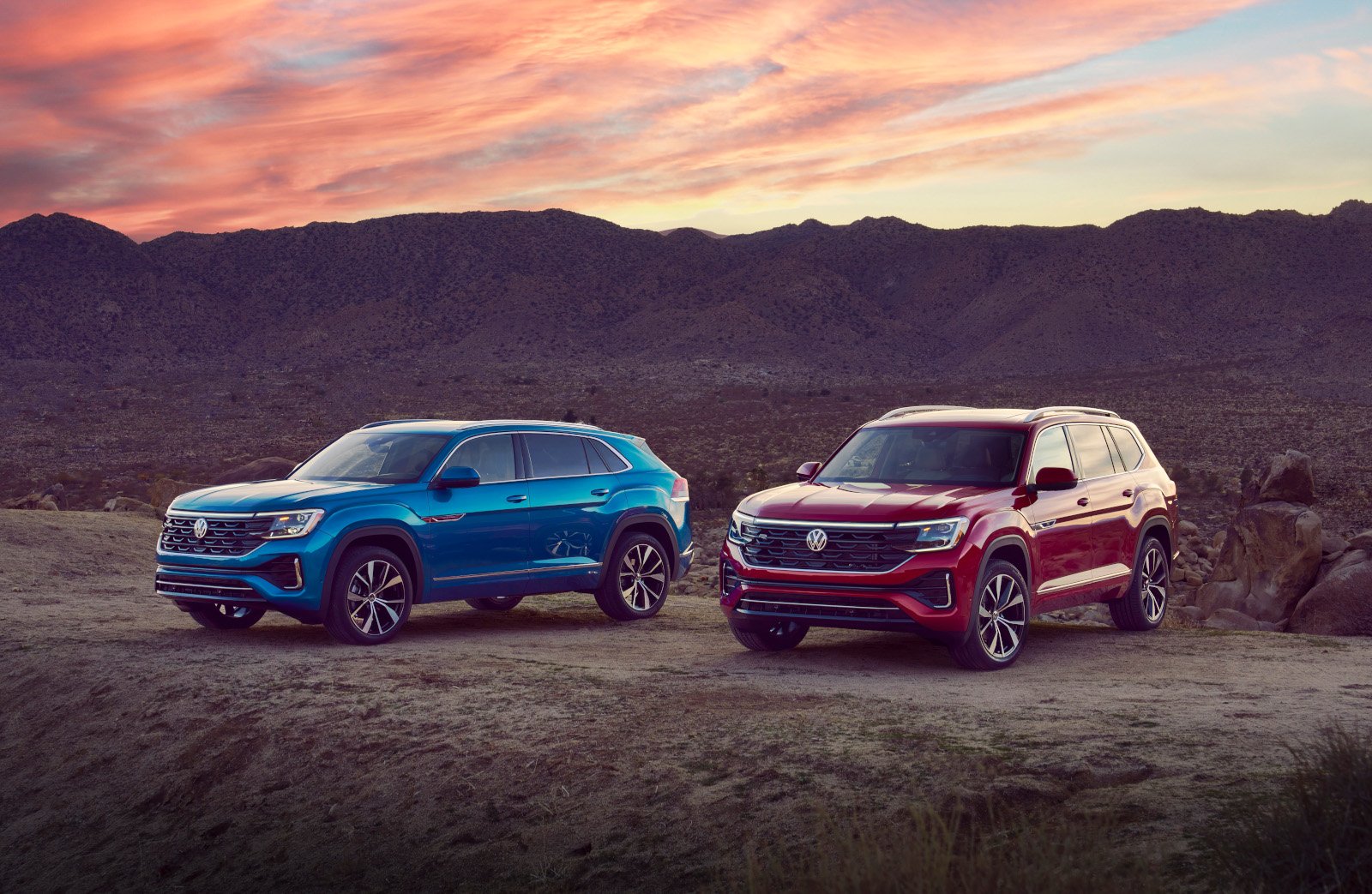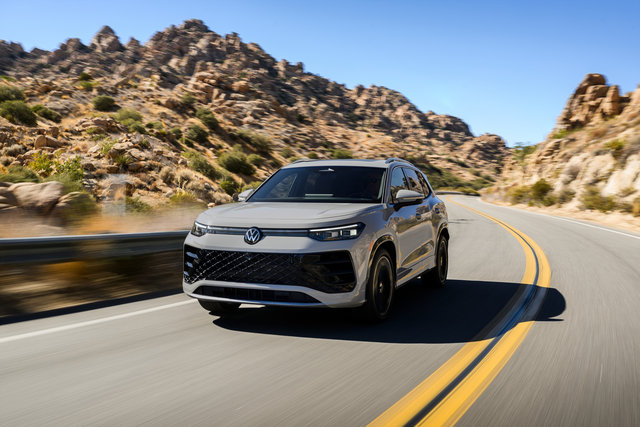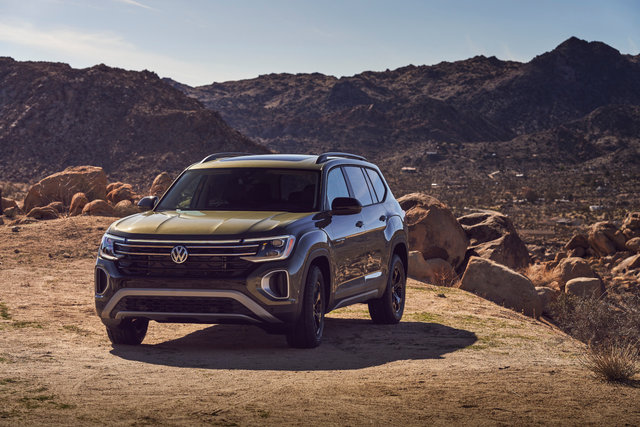Family Practicality vs. Sporty Style: Comparing the 2025 VW Atlas and Atlas Cross Sport
July 31 2025

Choosing between Volkswagen's two largest SUVs comes down to a simple question: Do you need maximum seating and cargo capacity, or do you prioritize sleek styling with still-generous space? Both the 2025 Atlas and Atlas Cross Sport share the same turbocharged engine and 4MOTION all-wheel drive system, but they serve different family needs.
The Atlas offers three rows of seating for up to seven passengers, making it the clear choice for larger families or those who regularly transport multiple children and their friends. The Atlas Cross Sport takes a different approach, offering a more coupe-like roofline with five seats and a focus on style over maximum utility.
Seating: Seven Passengers vs. Five with Style
The most significant difference between these SUVs lies in their seating arrangements. The Atlas provides three full rows of seating, accommodating seven passengers in a 2+3+2 configuration. The second row can be upgraded to captain's chairs for six-seat layouts, creating easier third-row access and a more premium feel.
The Atlas Cross Sport eliminates the third row entirely, focusing on five passengers with more cargo space behind the second row. This design gives rear passengers more legroom and headroom while creating a sportier exterior profile.
Both models feature heated front seats as standard, with higher trims adding ventilation and massage functions. Leather seating surfaces are available across multiple trim levels, with the Atlas offering slightly more upholstery choices due to its broader trim range.
Cargo Space: Maximum Utility vs. Daily Practicality
Cargo capacity reveals each vehicle's distinct purpose:
|
Model |
All Seats Up |
Behind 2nd Row |
Max Cargo |
|---|---|---|---|
|
Atlas |
583 L |
1,267 L |
2,735 L |
|
Atlas Cross Sport |
1,133 L |
1,133 L |
2,197 L |
The Atlas offers three distinct cargo configurations. With all seven seats in use, you get 583 L for groceries and daily items. Fold the third row down and cargo space jumps to 1,267 L. Fold all rear seats and you access the full 2,735 L capacity for large hauling jobs.
The Atlas Cross Sport provides 1,133 L of cargo space behind the second row, expanding to 2,197 L when those seats fold down. This design gives you substantial daily cargo room without needing to remove or fold a third row.
Dimensions and Styling: Function vs. Form

Both SUVs share the same 2,980 mm wheelbase and overall width, but their height and length differ:
The Atlas measures 5,097 mm long and 1,787 mm tall, giving it a more traditional three-row SUV appearance. The Atlas Cross Sport is shorter at 4,968 mm long and 1,729 mm tall, creating its distinctive coupe-like silhouette.
This size difference affects more than just appearance. The Atlas Cross Sport's lower height makes it easier to load roof cargo and fits better in some parking structures, while the Atlas's extra length provides more interior space but requires larger parking spots.
Performance and Capability: Identical Power, Similar Capability
Both models use the same 2.0 TSI turbocharged four-cylinder engine producing 269 hp and 273 lb-ft of torque. This engine pairs with an eight-speed automatic transmission and 4MOTION all-wheel drive across all Canadian trims.
Fuel economy remains identical at 11.1 L/100 km combined for both models. Towing capacity also matches at 2,268 kg (5,000 lbs), meaning either SUV can handle boats, trailers, or camping equipment with equal capability.
The shared platform means both vehicles offer the same driving dynamics, with 4MOTION providing confident all-weather traction for Quebec's varied road conditions.
Technology and Features: Nearly Identical Offerings
Both SUVs feature the same core technology:
- 12.0-inch touchscreen infotainment system
- Volkswagen Digital Cockpit Pro with 10.25-inch display
- Wireless App-Connect for Android Auto and Apple CarPlay
- Travel Assist with adaptive cruise control and lane keeping
- Standard LED headlights with Adaptive Front-light System
Higher trim levels on both models add features like the Harman Kardon premium audio system, panoramic sunroof, and Area View 360-degree camera system. The main difference lies in available trim levels, with the Atlas offering a Peak Edition variant not available on the Cross Sport.
Trim Levels
Both model lines start with Comfortline 4MOTION trim and build upward through Highline and Execline variants.
The Atlas Cross Sport adds a unique Comfortline R-Line Black Edition trim that emphasizes sporty styling with black exterior accents and 20-inch Venom black wheels.
Making Your Choice
Choose the Atlas if you regularly need seven seats, frequently haul large cargo loads, or want the maximum space Volkswagen offers. Families with three or more children, those who carpool regularly, or buyers who prioritize utility over style will find the Atlas more practical.
Choose the Atlas Cross Sport if you rarely need more than five seats, prefer sportier styling, or want easier daily cargo access without folding seats. Couples with older children, families who prioritize style alongside capability, or buyers who want SUV capability in a more manageable size will appreciate the Cross Sport's approach.
Visit Park Avenue Volkswagen to explore both models and determine which large SUV best matches your family's specific needs.
Other Articles That May Interest You
November 28 2025
How Volkswagen's 4MOTION All-Wheel Drive Handles Quebec WintersQuebec winters require a drivetrain engineered to handle months of snow, ice, and unpredictable road conditions. Volkswagen's 4MOTION All-Wheel Drive system distributes power intelligently across all four wheels to maintain traction when roads turn treacherous. From Brossard's morning commutes to weekend escapes in the Laurentians, 4MOTION-equipped Volkswagen models provide the traction Quebec...
November 25 2025
Can the 2026 Volkswagen Tiguan's Snow Mode Handle Unplowed Brossard Streets?South Shore residents know the drill: municipal plows clear main arteries like Taschereau Boulevard and Highway 132, but side streets and cul-de-sacs in Brossard often sit buried under packed snow for hours—or days—after a storm. If you're navigating uncleared residential roads on your morning commute or shuttling kids to school through icy ruts, you need a vehicle that won't hesitate when...
November 17 2025
2026 Tiguan vs. Atlas Buyer's Guide: Finding Your Family's Perfect Volkswagen SUVChoosing the right SUV for your family means balancing space, power, features, and budget. Volkswagen offers two strong options for families in Brossard and across the South Shore: the 2026 Tiguan and the 2026 Atlas. Both deliver the 4MOTION all-wheel drive, advanced safety technology, and German engineering that Volkswagen is known for, but they serve different family needs. The Tiguan offers...
Search in Our Inventory












